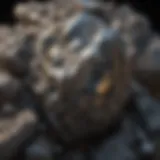Exploring Brazilian Geodes: Nature's Crystal Marvels
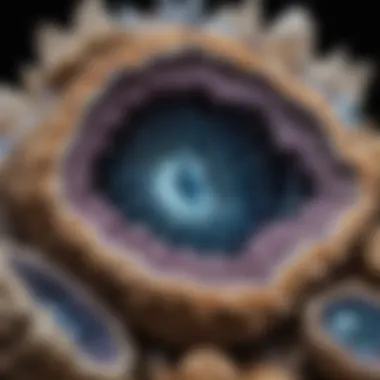

Intro
In the heart of Brazil lies a treasure trove of natural wonder — the geode. These fascinating geological formations, often camouflaged as unassuming rocks, hide beautiful crystals that create a lively spectacle when cracked open. The allure of Brazilian geodes extends beyond mere aesthetics; they embody a myriad of mineralogical stories, each telling a tale of the Earth's ancient processes. Enthusiasts and collectors from all walks of life are drawn to these formations, seeking their unique charms and understanding their significance in both natural history and modern applications.
As we embark on this exploration, we'll uncover not just the picturesque allure of these natural wonders, but also their origins, compositions, and the craftsmanship that transforms them into pieces of art. Also we'll delve into how to identify and collect these treasures, and how their beauty can be preserved and displayed in your own personal collection. Each section aims to provide insights that magnify appreciation for these crystal marvels, sharpening the understanding of both novices and seasoned collectors alike.
Intro to Brazilian Geodes
The allure of Brazilian geodes lies not just in their stunning visual appeal but also in their complex geological origins and unique mineral compositions. These crystal-laden cavities found in volcanic rocks or sedimentary layers are more than mere aesthetic treasures; they represent a fascinating intersection of art, science, and nature. For anyone in the realms of geology or mineral collection, understanding Brazilian geodes is both an intellectual pursuit and a gateway to appreciating the geological wonders underneath our feet.
Definition of Geodes
Geodes are hollow rock formations that often contain beautiful crystals or mineral deposits lining their interior surfaces. Essentially, they begin as bubbles in volcanic lava or as cavities formed in sedimentary deposits. Over time, these voids can fill with mineral-rich solutions that crystallize under pressure. To the untrained eye, a geode might look like an ordinary rock, but once sliced open, it reveals a spectacular world of shimmering quartz, amethyst, and other minerals. They act as a reminder of the dynamic processes that shape our planet and can serve as valuable indicators of geological environments.
Historical Context of Geode Discovery
The history of geode discovery is rich and layered, mainly tied to the cultural evolution in regions where these marvels are found. The ancient cultures of Brazil utilized quartz and amethyst geodes in their works, often incorporating them into spiritual or decorative artifacts. It was not until the late 19th century that geodes were recognized in the geological community, thanks in part to explorers and scientists expressing growing interest in mineralogy.
Brazil, in particular, became a key player in the global trade of semi-precious stones, showcasing a variety of geode types that would enchant collectors and artists alike. The discovery of the first significant deposits in places like Minas Gerais fueled a surge in interest that continues to this day. It’s important to note that these geological formations are not only limited to Brazil but have gained prominence in various parts of the world, contributing to a broader appreciation of Earth’s geological diversity.
Geological Formation of Geodes
Understanding the geological formation of geodes provides a window into their captivating beauty and complexity. These naturally occurring mineral formations are more than mere decorative pieces; they represent a unique intersection of geology, chemistry, and time. Grasping the processes and environments through which geodes form can deepen our appreciation of them, especially for collectors who cherish these natural marvels.
Formation Processes
The formation of geodes primarily occurs through three distinct processes: hydrothermal processes, lava tubes, and sedimentary environments. Delving into these processes reveals much about the formation and characteristics of Brazilian geodes.
Hydrothermal Processes
Hydrothermal processes are a significant driver in the creation of many geodes, particularly in regions with volcanic activity. In essence, this process involves the interaction of heated mineral-rich water with surrounding rocks. When these solutions cool, minerals precipitate, gradually filling cavities within the rock structure.
A key characteristic of hydrothermal processes is that they yield a diverse range of mineral deposits, leading to vibrant geodes containing quartz, amethyst, or even rare minerals. This aspect makes hydrothermal formation particularly beneficial for collectors seeking unique specimens.
However, there is a disadvantage to consider; the geological conditions required for significant hydrothermal activity are somewhat rare, which can limit the availability of specimens formed this way.
Lava Tubes and Volcanic Origins
Geodes formed in lava tubes are another fascinating aspect of their geological origin. Lava tubes form during volcanic eruptions, when the outer lava cools and hardens while the molten rock inside continues to flow. Over time, this can leave behind cavities which can fill with mineral solutions.
The key characteristic of these geodes is their often strikingly beautiful agate and onyx layers, formed as temperatures and pressures within the tubes fluctuate. This method of formation is intriguing because it often results in unique, intricate patterns that collectors are drawn to. One disadvantage is that while they are visually striking, the availability of these specific geodes might be limited to regions with active or past volcanic activity.
Sedimentary Environments
Various geodes also form within sedimentary environments, which often contribute to their distinct shapes and textures. These formations occur in porous limestone or sandstone layers, where mineral-rich water seeps in over thousands or millions of years.
A major advantage of sedimentary geodes is that they can contain a broader variety of materials sourced from their surrounding environments; as a result, they might reveal intricate layers of different minerals. On the flip side, they might not exhibit the same sparkling clarity found in hydrothermal or volcanic origins, which can affect their desirability among collectors.
Mineralization in Geodes
Mineralization is a fundamental aspect of geode formation, dictating the types of minerals within the cavities and therefore their overall appearance and value. Understanding this process helps shed light on why certain minerals are found in Brazilian geodes and what this means for collectors.
Role of Mineral Solutions
The role of mineral solutions in the crystallization process cannot be overstated. As water containing dissolved minerals works its way into rock cavities, these minerals precipitate upon cooling or evaporation. This interaction is key in transforming empty cavities into stunning geodes. A characteristic feature of this process is that it allows for a remarkable variety of minerals, including quartz, calcite, and various trace elements, to form beautiful crystal structures.
This contributes positively to the article's goal of emphasizing the diversity found in Brazilian geodes; however, not all mineral solutions yield desirable results. Sometimes the end product can be less visually appealing.
Types of Crystallization
Crystallization in geodes can occur through multiple mechanisms, each creating unique forms and structures of crystals. From simple geometric patterns to complex cluster formations, the type of crystallization can have a pronounced effect on the visual appeal and value of the geodes. Some prominent types include slow crystallization, producing large, well-formed crystals, and rapid crystallization, leading to smaller, more chaotic structures.
Understanding these types allows collectors to appreciate the artistry found within geodes. One downside to faster crystallization is that it often results in less defined shapes, which might not be as sought after by some collectors.
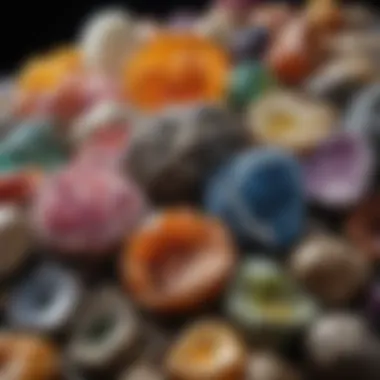

Characteristics of Brazilian Geodes
The characteristics of Brazilian geodes serve as a cornerstone of understanding these extraordinary natural formations. They not only provide aesthetic appeal but also contribute significantly to various practical applications, making them a focal point for collectors and enthusiasts alike. Gleaning insights from their distinct features allows us to appreciate nature's intricate craftsmanship in mineralization and geography. The beauty of Brazilian geodes lies in their diverse types and internal structures, which can reveal much about the geological history and environmental conditions of their formation.
Common Types of Brazilian Geodes
Amethyst Geodes
Amethyst geodes are like nature's own stained-glass windows. This variety is celebrated for its stunning violet crystals, which form from silicon dioxide. The allure of amethyst stems not just from its enchanting hue but also its perceived metaphysical properties; many believe it can promote calmness and clarity. These geodes often have a vibrant inner glow that can brighten any space, making them a popular choice among collectors.
One unique characteristic of amethyst geodes is their ability to show a range of purple shades, from light lavender to deep royal purple, often influenced by the presence of iron during formation. The larger, well-formed crystals tend to be in high demand, driving market prices upward. However, the popularity can sometimes lead to over-harvesting, prompting discussions about ethical collection practices.
Agate Geodes
Agate geodes are known for their remarkable banding patterns, which can be both visually striking and educational. They contain chalcedony layers that reveal their growth history. Collectors often appreciate agate for its unique colors and textures, and it’s not uncommon to find these geodes containing quartz crystals nestled within them.
What sets agate geodes apart is their durability; they can hold their own under various conditions, making them ideal for educational purposes as well as decorative pieces. However, the time-intensive process of cutting and polishing these geodes, if not done properly, can sometimes diminish their natural beauty, which is a consideration for potential buyers.
Citrine Geodes
Citrine geodes, with their warm yellow hues, are often dubbed the "merchant's stone" due to the belief that they attract wealth and prosperity. The golden crystalline formations provide a delightful contrast to other geodan gem types. These geodes are relatively rare, and their deep, rich shades are highly sought after in both jewelry and decor.
One critical feature of citrine geodes is that they are often misrepresented in the market. Many specimens labeled as citrine are actually heat-treated amethyst, which might not retain the coveted characteristics collectors cherish. Understanding these distinctions is vital for collectors who aim to acquire genuine specimens without falling for potential scams.
Structural Features
Interior Cavities
The interior cavities of geodes are fascinating microcosms that reflect the conditions under which they formed. These hollow spaces often host crystals that have the potential to grow in various sizes and shapes, creating a three-dimensional landscape that begs exploration. The interiors can sometimes surprise collectors with unexpected formations or clusters, leading to captivating discoveries.
One notable aspect of interior cavities is the varying sizes; they can range from small pockets to expansive hollow spaces. This variability allows geodes to appeal to different collector preferences, whether they're seeking a small decorative piece or a larger display item. However, the hollow nature can also make them fragile, especially if mishandled, so understanding how to properly store and display these treasures is crucial for maintaining their integrity.
Crystal Shapes and Sizes
The shapes and sizes of crystals within Brazilian geodes can range from pointed clusters to more rounded formations. This diversity adds to their charm and appeal, sparking interest among rock collectors and local artisans who utilize these geodes in their crafts. Each geode tells a story of environmental conditions and mineral availability at the time of its formation.
One benefit of having various crystal shapes and sizes is the ability to create unique displays that can complement any decorative theme. However, the lack of standardization in size can lead to differing market values, which is a point of confusion for some collectors. Consistently educating oneself on how these characteristics affect value can enhance a collector's ability to make informed purchases.
Ultimately, the characteristics of Brazilian geodes shed light on the artistic phenomenon of nature, showcasing both the beauty and complexity inherent in these geological wonders.
Geographical Distribution of Brazilian Geodes
Understanding the geographical distribution of Brazilian geodes is crucial to comprehending their uniqueness and the factors that contribute to their formation. Brazil stands out as a veritable treasure trove of geodes that exemplify nature's artistry. This country is known for its rich geological diversity, which makes it a hotspot for mineral enthusiasts and collectors alike. One can appreciate the accessibility of various types, such as amethyst and agate geodes, across some regions, leading to a thriving market for these natural wonders.
Key Regions in Brazil
Espirito Santo
Espirito Santo is noteworthy for its stunning amethyst geodes. This state is nestled in the southeastern part of Brazil and presents an ideal environment for the formation of these captivating crystals. The key characteristic that sets Espirito Santo apart is its geological makeup, rich in volcanic rocks and sedimentary layers. The unique combination of these elements promotes the growth of vibrant purple amethyst crystals. With numerous mines open to collectors, Espirito Santo becomes a popular choice for those looking to procure high-quality geodes. However, the accessibility of resources raises concerns regarding sustainable mining practices, requiring careful navigation by collectors.
Minas Gerais
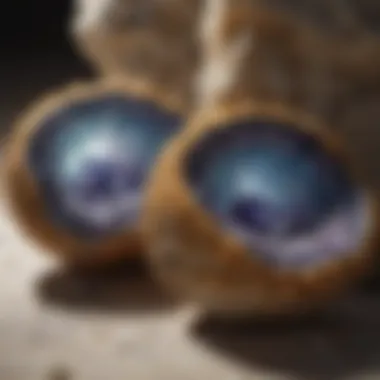

Minas Gerais, the heart of Brazil's mining industry, deserves a spotlight for its impressive variety of geodes. Known for housing some of the largest and most aesthetically pleasing amethyst geodes, this state is often deemed the epicenter of geode collection. Minas Gerais benefits from abundant mineral-rich deposits that transition into geode formation. The unique feature here lies in the sheer size of certain geodes, which can reach several feet in diameter. Despite the allure, the market's demand has led to increased competition among collectors, which can drive prices up. The stunning beauty of these geodes consistently positions Minas Gerais as a favorable destination for enthusiasts aiming to enhance their collections.
Rio Grande do Sul
Rio Grande do Sul presents a different landscape in the narrative of Brazilian geodes. This southern state is specifically known for its agate geodes. The landscape there is diverse, encompassing both mountainous regions and flatlands, which contributes to a unique geological mix that favors agate formation. One of the remarkable aspects of Rio Grande do Sul is the wide variety of colors and patterns found within agate geodes. This richness in appearance attracts collectors who value distinctive aesthetics in their geodes. However, the regional climate and environmental changes pose challenges to maintaining these natural formations, making preservation efforts an essential consideration for collectors and local authorities alike.
Environmental Conditions Favoring Geode Formation
The environmental conditions in these regions are pivotal to the development of geodes. Factors such as temperature fluctuations, mineral-rich water sources, and volcanic activity play significant roles in shaping these crystal structures. The interplay of these elements not only aids in the growth of geodes but can also influence the types of minerals found in them.
"The beauty of Brazilian geodes is a testament to nature's ability to transform the mundane into the magnificent."
In summary, it is evident that the geographical distribution of Brazilian geodes serves as a canvas for exploring mineral diversity, aesthetic beauty, and ecological considerations. Highlighting regions such as Espirito Santo, Minas Gerais, and Rio Grande do Sul provides invaluable insights into what makes Brazilian geodes some of the most sought-after natural treasures in the world.
Applications of Brazilian Geodes
Brazilian geodes are more than just stunning natural formations; they embody a blend of art and science that enhances our understanding and appreciation of the world. The applications of these geodes extend into various fields, encompassing everything from aesthetic decor to educational exploration. Their appeal lies not just in their beauty but also in their versatility and functionality.
In Art and Design
Decorative Items
When people think of decor, few items can compete with the striking visual appeal of geodes. Decorative items made from Brazilian geodes often serve as conversation starters, catching the eye with their unique patterns and colors. These items can range from coffee table displays to wall art, each piece a testament to nature's artistry.
The key characteristic of decorative geode items is their natural design. Unlike mass-produced decor, each godes is genuinely one-of-a-kind, making it a sought after choice for collectors and enthusiasts alike. Whether placed in a living room or an office, these pieces bring nature indoors, creating a serene ambiance.
One unique feature of decorative items is the variety of colors and forms you can find, especially in agate and amethyst geodes. While advantages include their ability to elevate any space aesthetically, disadvantages may involve higher costs due to rarity and the fragility of these natural formations, making them a challenge to incorporate into high-traffic areas.
Jewelry Making
The jewelry industry has been significantly impacted by the incorporation of Brazilian geodes. Their vibrant hues and striking crystal formations lend themselves perfectly to unique pieces that stand out. Jewelry made from geodes, such as pendants and earrings, often showcases their natural beauty while providing a versatile accessory for various outfits.
The key characteristic of geode jewelry lies in the organic shapes and textures that each piece possesses. This irregularity contributes to its charm, as every piece tells its own story. Brazilian geodes offer artisans a chance to work with materials that are both beautiful and sophisticated, making them a popular choice in custom jewelry creations.
With unique features like their inherent such varieties, geode jewelry can be a conversation piece and present challenges related to wear and tear. While they may be enchanting, the disadvantages include securing a durable setting that can withstand daily use without compromising the natural beauty of the stone, often leading to considerations about the longevity of the piece.
Use in Science and Education
Geological Research
Brazilian geodes have carved a niche in geological research due to their complex formation processes and mineralization. Scientists often study these geodes to gain insights into geological history. Understanding the conditions under which they form can reveal a lot about the Earth's crust and environmental changes over millions of years.
The key characteristic of geological research on geodes is its interdisciplinary approach, blending geology, mineralogy, and environmental science. Researchers often use these natural wonders to illustrate broader concepts of earth science and geology, making them a beneficial resource for educational purposes.
The unique feature of geodes in research is the range of minerals they contain. Analyzing this diversity helps unravel past geological events that shaped the current landscape. However, there are disadvantages, such as the sometimes limited availability of intact specimens for study, which can hinder extensive geological understanding.
Educational Displays
Geodes also find a place in educational displays, making them invaluable tools for teaching about geology and natural sciences. Schools and museums use these stunning formations to engage students and visitors in learning about earth sciences in a visually captivating way.
The key characteristic of educational displays featuring Brazilian geodes is their interactive element. Hands-on exploration of geodes can foster curiosity among students, which is critical for sparking interest in geology and mineralogy. They provide tangible connections to the lessons being taught, making complex concepts more relatable.
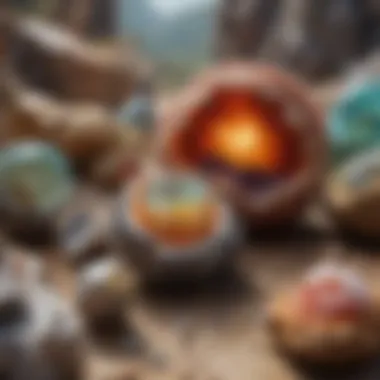

One unique feature of these displays is the opportunity for comparative study. Presenting various types and sizes of geodes allows educators to show the diversity within a single category of geological formations. The advantages include heightened engagement and understanding among learners, while the disadvantages might be the maintenance and secure display of fragile items in a school or museum setting.
Understanding and appreciating the applications of Brazilian geodes is not just limited to their beauty. It extends into the realms of creativity and education, enhancing our grasp of the natural world and its history.
Collecting Brazilian Geodes
Collecting Brazilian geodes brings together enthusiasts who share a fascination with these spectacular natural treasures. The act of collecting not only amplifies appreciation for geology but also creates a connection to nature in its rawest form. Each geode tells a story, often dating back millions of years, inviting collectors to trace its journey from formation to their hands.
Guidelines for Collectors
Legal and Ethical Considerations
Respecting the law is crucial in geode collecting, especially when it comes to sourcing. Collecting geodes from protected lands, for instance, can lead to hefty fines and environmental damage. It's important for collectors to research local regulations, ensuring their hobby doesn't interfere with conservation efforts. The key aspect of this is fostering respect for natural resources, which can cement a collector's reputation positively in the community.
Many collectors find that ethical sourcing—working with established dealers or extracting from permitted sites—not only elevates their ownership experience but also enhances the legitimacy of their collection. A unique feature here is the growing trend towards traceable collections, where individuals know the exact provenance of their pieces. This not only resonates with conscious consumers but could potentially increase the value of their collection in time.
Best Practices for Preservation
Once collected, proper care of Brazilian geodes is vital to maintain their stunning appearance and prevent deterioration. Best practices involve controlling environmental factors such as humidity and temperature. Many collectors advocate for display cases with UV filters to protect geodes from fading sunlight, thereby prolonging their lifespan.
Additionally, a key characteristic of preservation is how collectors handle cleaning. It’s often advised to avoid harsh chemicals, favoring gentle methods like distilled water or a soft brush. This practice not only safeguards the integrity of the geode but also preserves its market value. Collectors may find that well-maintained specimens can fetch a better price, illustrating the importance of diligent care.
Valuation and Market Trends
The landscape for geode valuation is influenced by multiple elements, making it an evolving market. For collectors, understanding these factors can guide their investments. A noteworthy characteristic here is that quality often outweighs quantity; rare types, like exceptionally vibrant amethyst geodes, can command sky-high prices.
Factors Influencing Value
Several criteria determine the worth of Brazilian geodes. Color saturation, clarity of crystals, and the overall aesthetic appeal play significant roles. Collectors often deliberate on the rarity of the mineral content, as specific gems like citrine commonly have higher demand yet are less frequently found in pristine conditions.
Moreover, size is another differentiating factor. Large geodes, especially those that are intact and visually striking, can be particularly lucrative. A unique feature to note is that local market preferences can shift, affecting demand regionally, which can benefit collectors who understand these nuances.
Current Market Insights
Currently, there’s a noticeable surge in the popularity of natural decor, influencing demand for geodes. The trend towards sustainable and unique home aesthetics makes these crystal marvels highly sought after. Collectors can observe rising prices for certain types as they become fashionable commodities.
Furthermore, online marketplaces have broadened access to a global audience but can also introduce risks in terms of authenticity. It's advisable for collectors to stay updated through platforms like Reddit or specialized marketplaces where they can gauge pricing and trends actively.
In essence, the realm of Brazilian geodes is not merely about collecting but a pathway to understanding geological history, market strategies, and ethical considerations. Engaging with these facets can vastly enrich the experience of collecting.
Epilogue: The Allure of Brazilian Geodes
The exploration of Brazilian geodes culminates in an appreciation of their captivating beauty and intrinsic value. These remarkable crystal formations are not just eye-catching; they are a testament to the intricate processes of nature. From their unique geological formations to their diverse mineral compositions, Brazilian geodes offer a window into the intricate tapestry of Earth's history.
Reflection on Their Natural Beauty
Brazilian geodes are a feast for the eyes, cradling a spectrum of colors and shapes that can mesmerize anyone who lays eyes on them. Amethyst, agate, and citrine geodes are among the most celebrated, each showcasing nature’s palette. The dark, rich purple of amethyst, with its shimmering crystals, invokes a sense of serenity. On the other hand, the vibrant yellows and oranges of citrine radiate warmth and vitality.
Each geode tells a story through its formations: the delicate arches of crystals, the smoothness of the inner cavities, and the patterns that emerge from their mineral contents. It's this interplay of textures and colors that makes each specimen unique, almost like nature's fingerprint. The sheer variety found across Brazilian landscapes allows collectors and enthusiasts to curate displays that reflect their individual tastes and interests. Thus, every geode becomes not just a specimen, but a conversation starter, drawing attention to the wonders of geology.
Encouragement for Further Exploration
For those captivated by the allure of geodes, there is always more to discover. The world of Brazilian geodes is both vast and dynamic, offering avenues for personal exploration as well as areas for scientific inquiry. Engaging with local rock and mineral clubs can deepen one’s understanding, providing access to knowledgeable individuals who share a passion for these natural treasures. Additionally, exploring geological sites in Brazil can heighten appreciation and offer firsthand experience of how these geodes form.
There are also numerous resources available for enthusiasts who wish to learn more about the complexities of geodes. Online platforms, such as Reddit's geology community, can provide insights and discussions that further enrich one’s knowledge. Websites like Wikipedia and Britannica can be great starting points for deeper research into the geological processes that create these wonders.
"With every discovery, the story of our planet unfolds further. Brazilian geodes are not merely collectibles; they are tokens of Earth’s history, waiting to be appreciated and understood."
